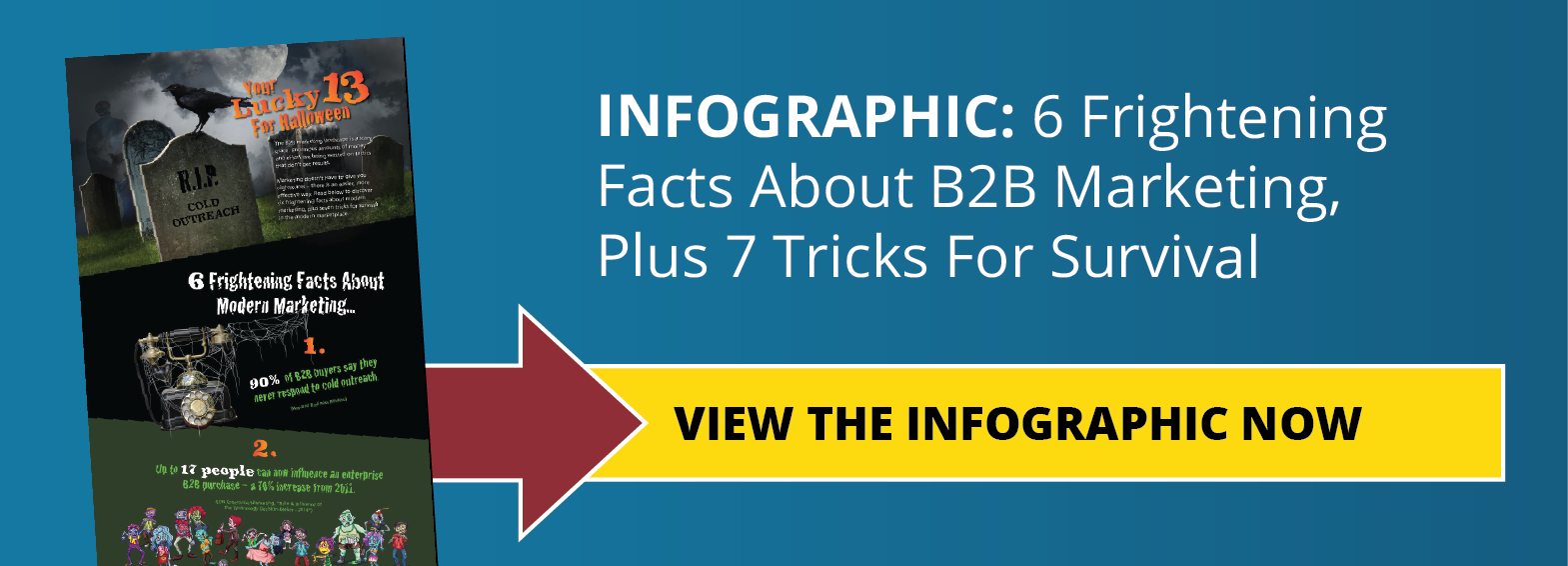
BOO! Your Sales Process Might Be Scaring Off Prospects
Ever Wonder Why Prospects Go Underground? It Might Be Because You Scared Them
“What happened to Company Zed? I thought they were so excited to get started. Why did they go underground?”
Sales leaders and CEOs are asking their sales reps this kind of question every day. Worse, sales reps all over the globe are bungling their sales process, pushing perfectly good prospects to seek shelter in the arms of your competitors.
Your sales process has only one mission, and no, it is not to close new customers. Its single mission is to make your prospects feel safe. If they feel safe, they will say yes. If they feel safe, they will sign your agreements, agree to your terms and spend more money with you. And if you keep them feeling safe, they will be with you for a long time.
Here’s how to do it.
Before I get started, I was reviewing a client testimonial video last night, and one of our clients had this to say: “From the very first phone call, I just felt different talking to Square 2.”
Does this sound like someone who was concerned about price, anxious about who’s going to be assigned to their account, worried around what we’re going to deliver to them or interested in how long we’ve been in business? Of course not.
What you’re hearing is an emotional response to an experience she had with our company. It was an experience that put her at ease, made her feel safe and secured her trust in the very first 30-minute phone call. It was our client to lose.
This doesn’t happen by accident. Making people feel safe is the result of years of tweaking, upgrading, updating and adjusting our own sales process. We have a philosophy we use – help them feel safe.
Let’s get started. Here are several ways you can help your prospects feel safe in the sales process. The results? You close more, close more frequently and close them faster.
Ask More Questions
I start with this upgrade because it’s generally the easiest to install. Sales reps are trained to ask questions, but many don’t ask enough and almost all of them don’t ask the right questions.
First, you have to understand that people like talking about themselves and their businesses. It’s usually pretty easy to get them talking. They get comfortable and they let their guard down. If you ask good questions, they start to like you and feel like you’re smart.
But these questions have to be strategically crafted to get you to your goals. You have to know enough about your prospect to create the recommendations they need to solve their pains. Almost everyone wants a custom solution, and no matter what you’re selling, you need to make your prospects feel like you’re building something just for them.
Sometimes the best questions are the hardest ones. Here are some of my favorites:
How are you going to decide which agency to hire? Who’s going to be involved in that discussion? When do you think you’ll have those conversations and when do you expect to have a decision?
Do you have a budget allocated for this project?
Sidebar: This is a tricky question but an important one. Most people don’t want to answer this. They think that your proposal and recommendations will be in line with their budget, and they don’t want to overspend if they don’t have to. They should have a budget and they should want you to bring your recommendations in line with that budget. But people don’t always act logically. So I like to ask this follow-up question:
OK, you don’t have a budget, or you don’t want to share it with us. That’s understandable. But what were you expecting this type of project to cost? You must have some range of where you thought it would land, right?
Another Sidebar: We all have some expectations around price for everything we buy or are thinking about buying. Getting them to answer this is easier and still helps you qualify and customize your recommendations.
Now back to the questions:
How big of a priority is this project for the company? An A priority has to be done in the next 30 days. B priorities can wait until next quarter, and C priorities are nice-to-haves but not need-to-haves. Where are you: A, B or C?
What other solutions are you considering? Are you talking to other potential partners? Have you decided that this can’t be done in-house?
When did you want to get started?
If you don’t hire us or any agency, how will that decision impact your business goals? What are the potential outcomes from that decision? Are those outcomes acceptable?
These are just some of the hundreds of questions we ask all through our sales process. We actually use a very specific diagnostic diary filled with technical questions that we need answers to when it comes to crafting our recommendations.
Some of those include questions like:
How many monthly visitors do you get to your website?
How many new contacts? How many marketing-qualified leads (MQLs)? How many sales-qualified leads (SQLs)? How many sales opportunities?
What is your close rate on proposals submitted?
What does your current tech stack look like? Are you happy with those tools? What are your challenges?
How aligned is sales with marketing? How often do you meet? Do you have shared goals? Is there an service-level agreement (SLA) in place?
How happy are you customers? Are they active as references? Do they write reviews? Will they go on video?
You get the idea. These questions uncover all kinds of opportunities. They unlock strategic conversations that help us position our expertise, but most importantly, they are designed to help people who don’t know us well start to know, like and trust us. Once someone knows you, trusts you and likes you, they feel safe.
Remember, that is our goal.
Leverage More Content
This is usually fairly easy, too. But in some cases, you might be missing the content you need to leverage educational material in the sales process.
When you’re talking to prospects and they share their issues or challenges with you, that’s the time to tell a story about how you helped a similar customer with similar challenges. Keep the story short, but back it up with a piece of educational content that you share offline.
“Let me send over a more detailed case study that shows you how we delivered a complex website to a client just like you in only 30 days. I’ll email it to you as soon as we get off the call.”
You sales rep’s job is not to sell them but to guide them, and the more education you can deliver, the better a guide they’ll be and the safer the prospect will feel.
This is where video in the sales process makes all the difference in the world. You can send a long email, or you can send a short video. You can attach a 20-page whitepaper, or you can attach a three-minute video. These videos allow people to connect on a personal level. They get to see faces and hear tonality in the commentary.
Consider adding video to help your sales reps get prospect to feel safe faster.
Go Slow To Go Faster
Speaking of speed, I know everyone wants to shorten the sales cycle. But sometimes speed makes people feel more uncertain.
For example, if you speak to a prospect at 9 a.m. and then get them a proposal by 10 a.m., how long did you actually think about their specific set of challenges? How much time did you put into that document? Did you talk to anyone else or just replace the name of the last prospect with their name before sending it over? Now they’re anxious.
I know you want to be responsive and speedy. But sometimes it’s better to slow down, take your time, do the job correctly and give them the perception that you’re taking your time. No one wants to feel rushed.
Don’t take too long, but do take as much time as you think they think you need to come up with thoughtful, creative, appropriate and well-designed recommendations.
In the end this will help them move forward more quickly than if you spit something out just to get the task done.
Control The Process
This is very important. If you’ve been in sales long enough, you know that eventually you’ll find someone who says something like, “I don’t really care about your process. Just get me a proposal by tomorrow end of day if you want the business.”
Your response has to be, “I’m so sorry, but that’s not how we work. We’ve been doing this for a long time, and our goal is to help you select the right agency for you and for us to make sure you’re the right client for us. That’s how our clients get such an amazing experience with us. Fit is critical. Is this important to you, too? Because if it is, we’re going to ask you to allow us to follow our process.”
If they say no, you pass on the work, no matter what. But in most cases, they accept your position and agree to follow your process.
This also means you have to be able to articulate the process in detail each step of the way. You need to have your process documented in writing, and preferably also in a visual format, similar to a flow chart.
Each step should be clearly identified, each communication clearly tagged and each piece of content marked with go/no-go milestones along the way. These off-ramps are important. When people opt out of your process, they need to be offloaded in a professional and productive way. They need to be just as happy when you’re not a good fit as they are when you’re the perfect fit and they are excited to continue the process.
Consider recommending them to a different firm and making an introduction. Consider sending them some material that might help them do it themselves. Or consider giving them some homework that once completed you’d be willing to revisit the conversation around working together.
Having a bit of exclusivity in your process makes people want to work with you even more. Remember how you felt when the girl or boy at the party didn’t want to dance with you? You wanted them to like you even more. Humans are constantly wanting what they can’t have, so building that into your process is important.
Get To No Early
A lot of salespeople are afraid to hear no. But that’s the wrong approach. You want a sales process that quickly gets to no.
You can’t afford us? That’s OK, let’s wrap up. I know another agency that might be a better fit.
Your CEO won’t join us? No worries, but we can’t continue, because this is a strategic initiative and they have to be involved.
You don’t value strategy? We’re not the right firm for you.
In the very first call, you should be looking for reasons to qualify out potential prospects. You don’t want to spend weeks with someone only to get to no at the very end.
In fact, your entire process should be filled with check points that help you ensure you get to no as early as possible.
This is also how you improve your close rate from 30% to 80%. The more people you remove from the sales process early, the more people you have time to work with who are more likely to choose you.
 Map Out The Process And Create Memories
Map Out The Process And Create Memories
Finally, people remember stories. Creating memories is one of the secrets to getting people to know, like and trust you. It helps people feel safe, especially when they can share that story with others.
Here’s an example: I can’t believe they sent me a copy of their book. I shared that story with three other people in the company, and I even purchased a few other copies of the book to share around the organization.
And here’s another example: These guys sent be a box with marshmallow fluff in the box. The box came with a little insert that was an NDA and included a story about how they’re the no-fluff agency. That resonated with me, and we made fluffernutter sandwiches for lunch.
In fact, we have a number of very specific and designed touch points across our sales process intended to create a memory, help us stand out and position us as different from other agencies they may be talking to.
I also go back and ask most of our new clients why they selected Square 2, and more times than not, they mention how they felt like we listened to them better than the other agencies.
This is a direct reflection on the way we work with people in our sales process, and it’s clearly an expectation that is important to the people we’re talking to.
So what’s the big takeaway here?
You worked hard to generate leads and get people into your sales process. But your sales process is an equally important element of someone’s experience with your company. You have to get this right.
I go so far as to say it’s even more important than your content marketing, website or email marketing efforts. If you don’t have a sales process that makes people feel safe, you’re going to be wasting a ton of opportunities.

CEO and Chief Revenue Scientist
Mike Lieberman, CEO and Chief Revenue Scientist
Eliminate Hit-or-Miss Marketing Moves
Get advice, tips, tools and guidance to generate more leads for your company in this weekly email newsletter.



Eliminate Hit-or-Miss Marketing Moves
Get advice, tips, tools and guidance to generate more leads for your company in this weekly email newsletter.














